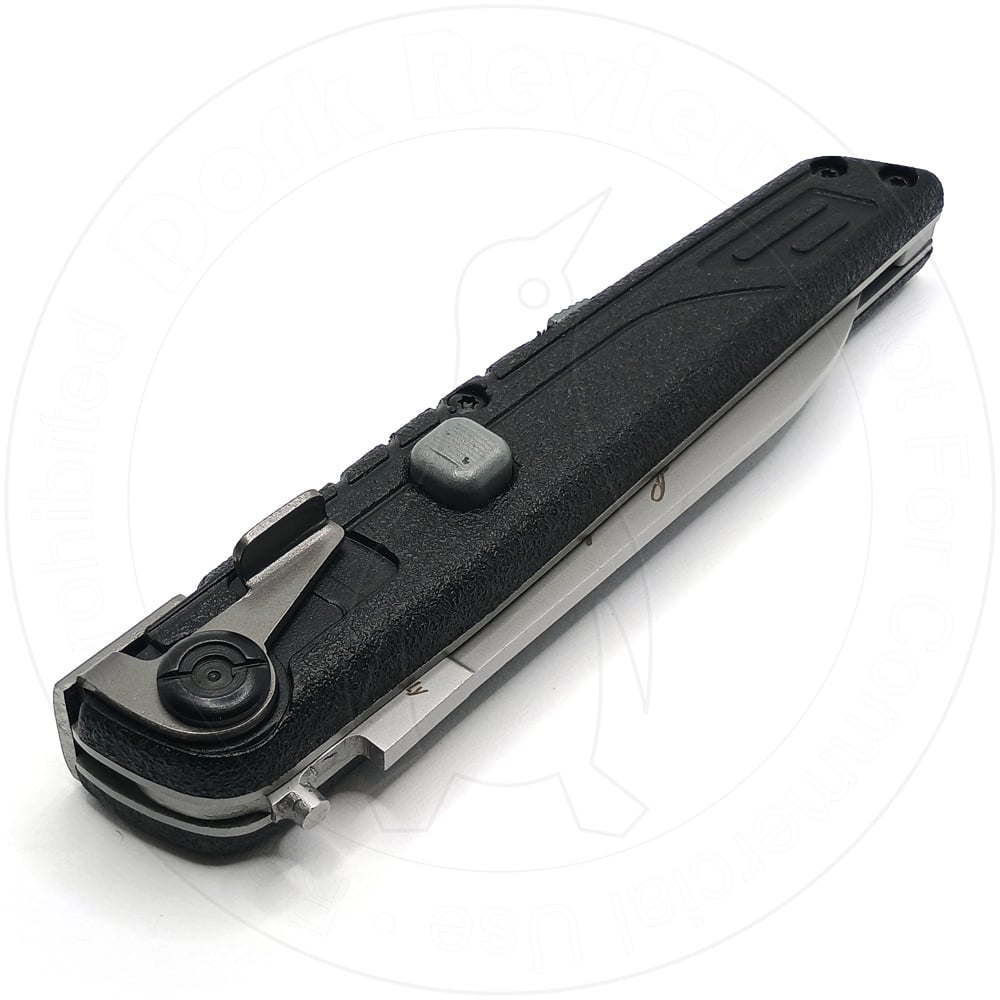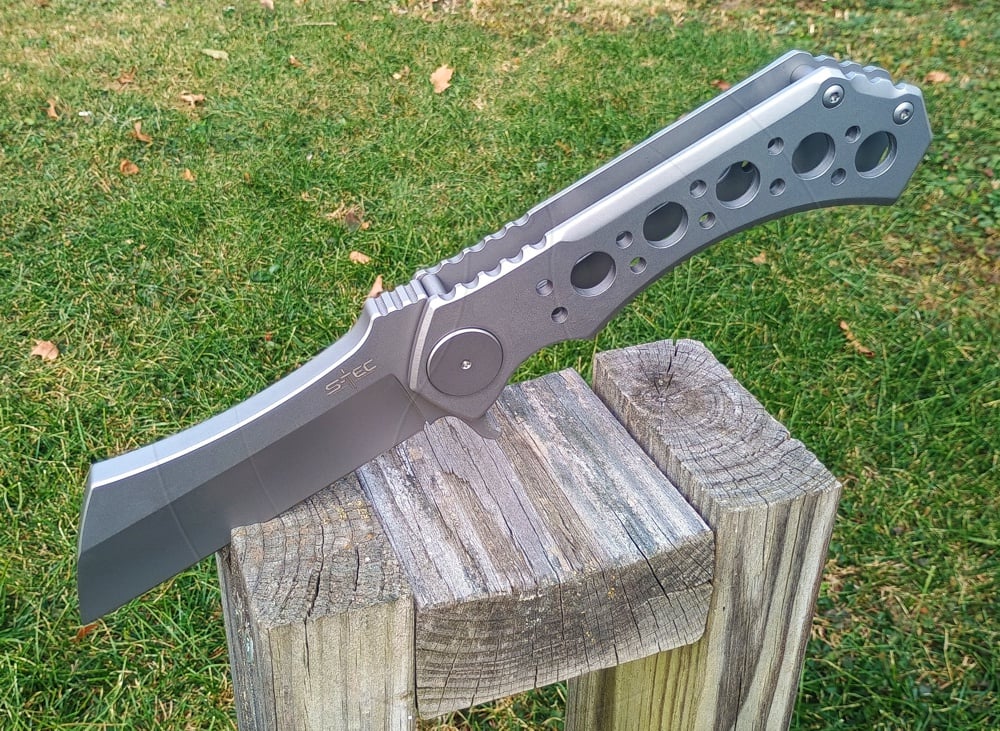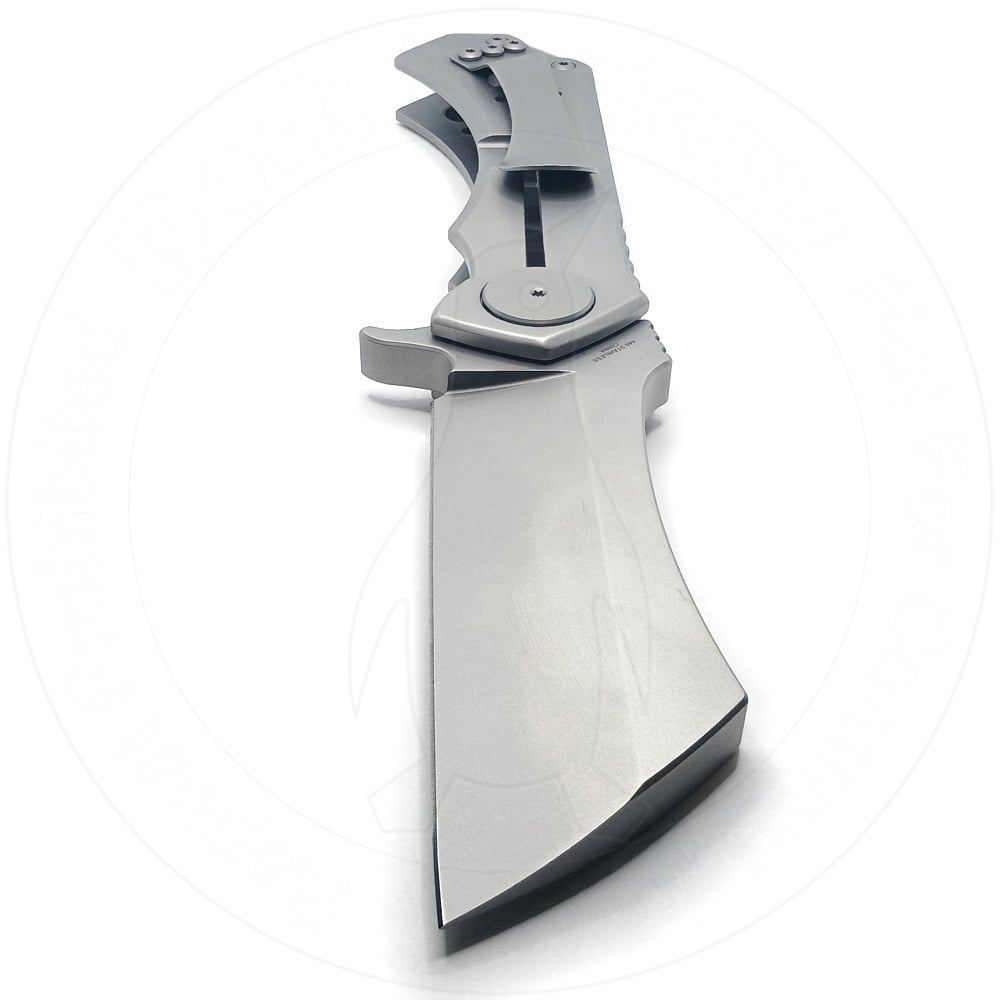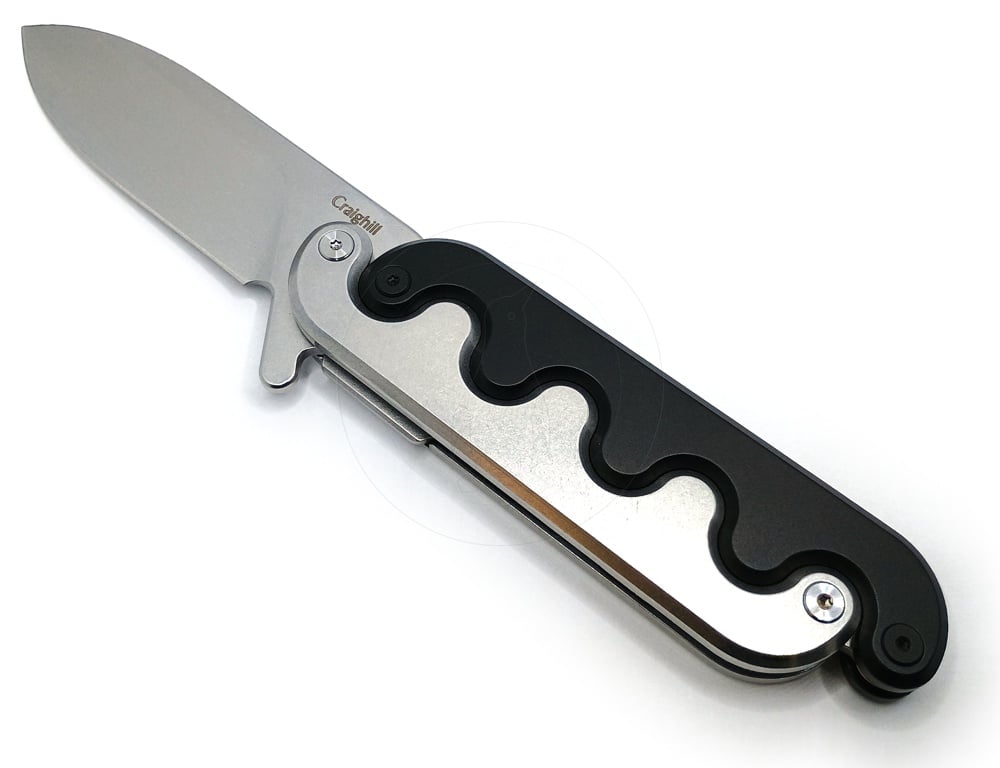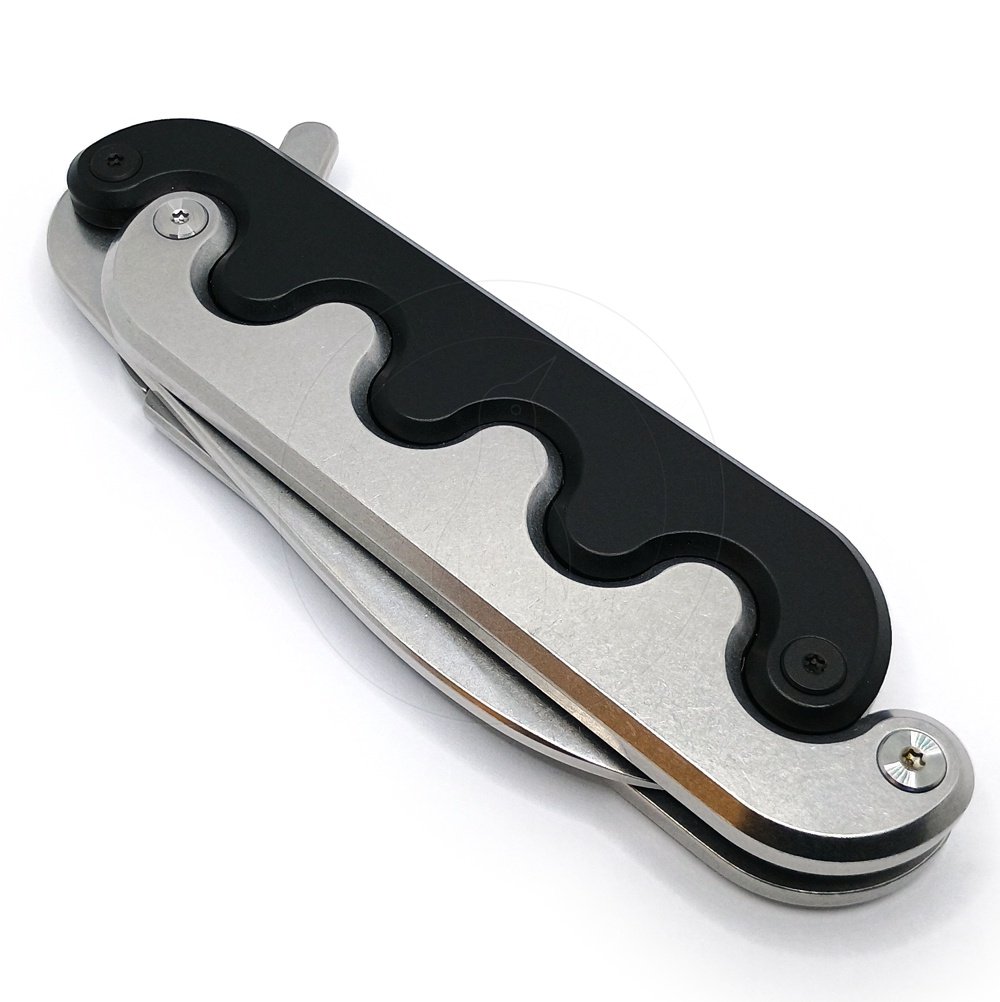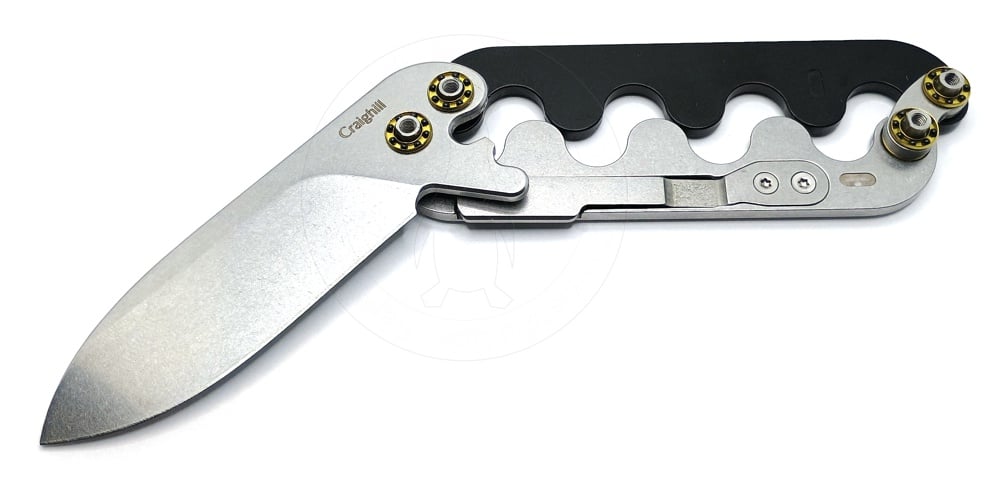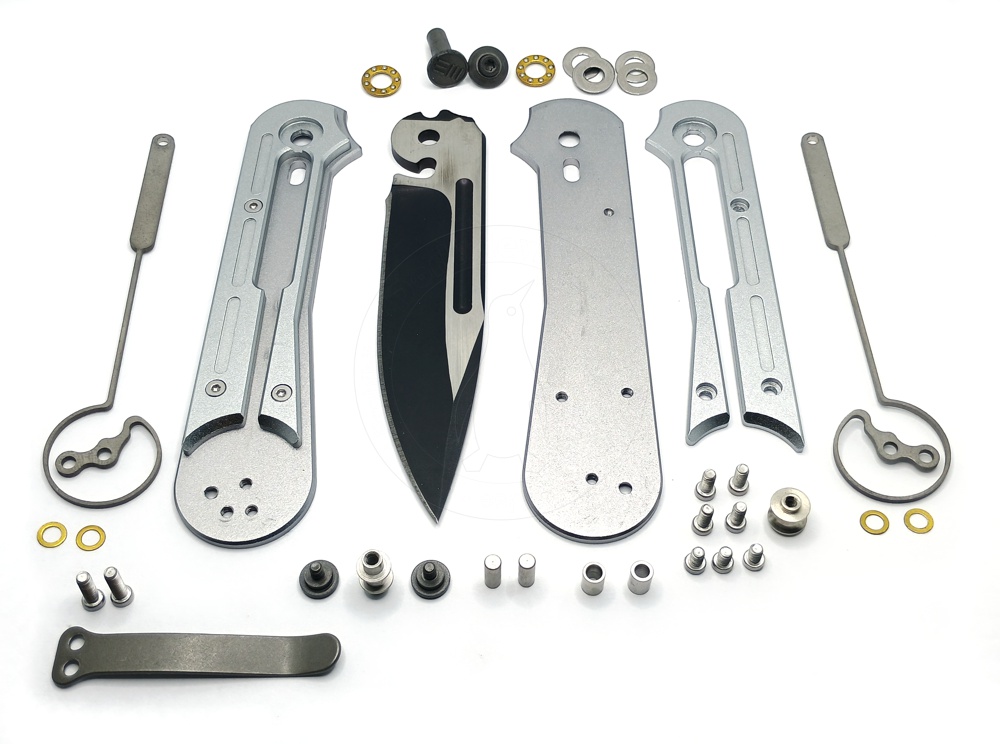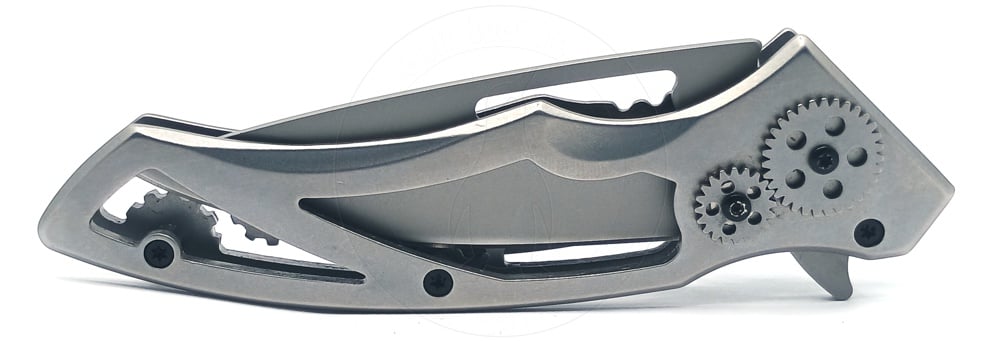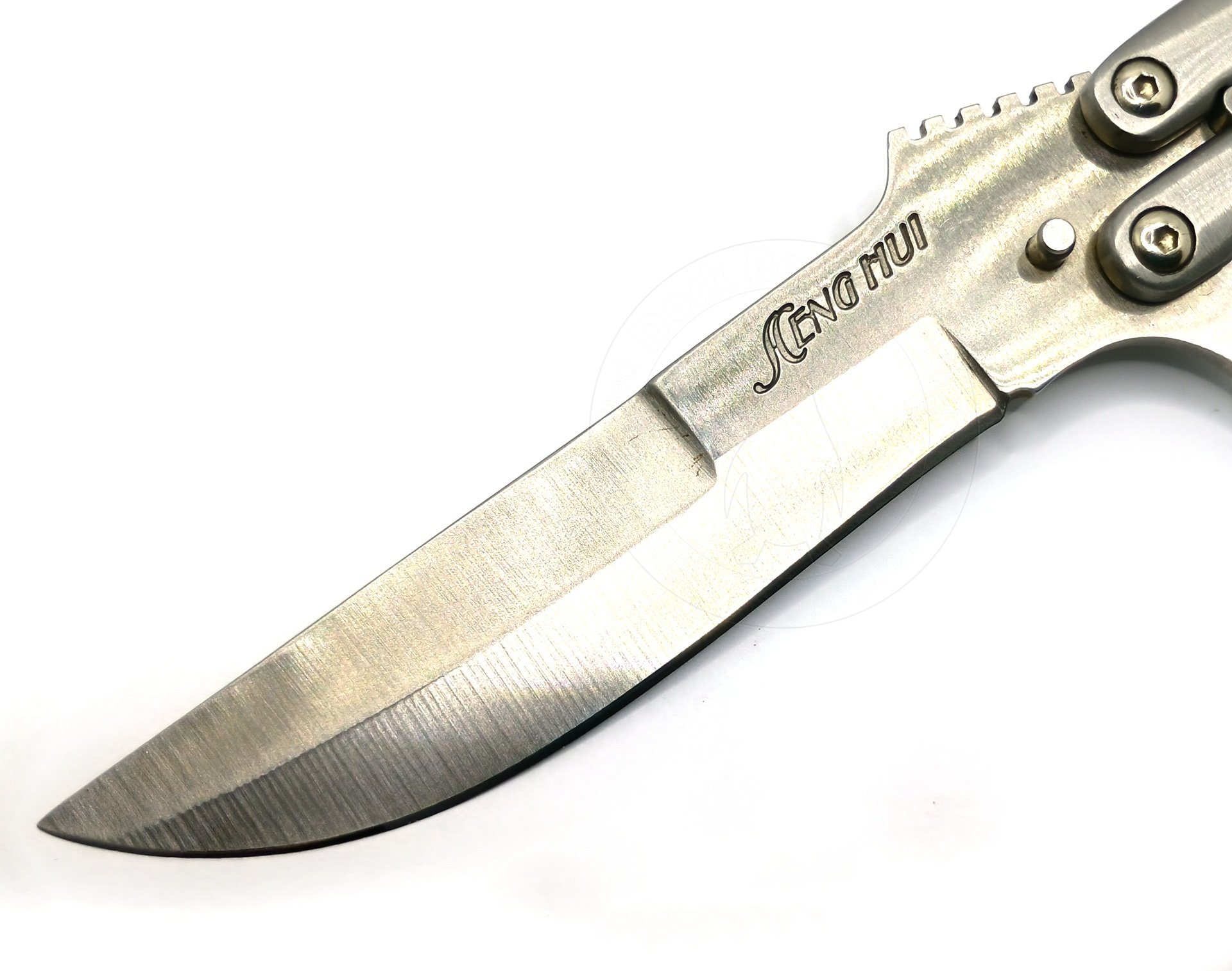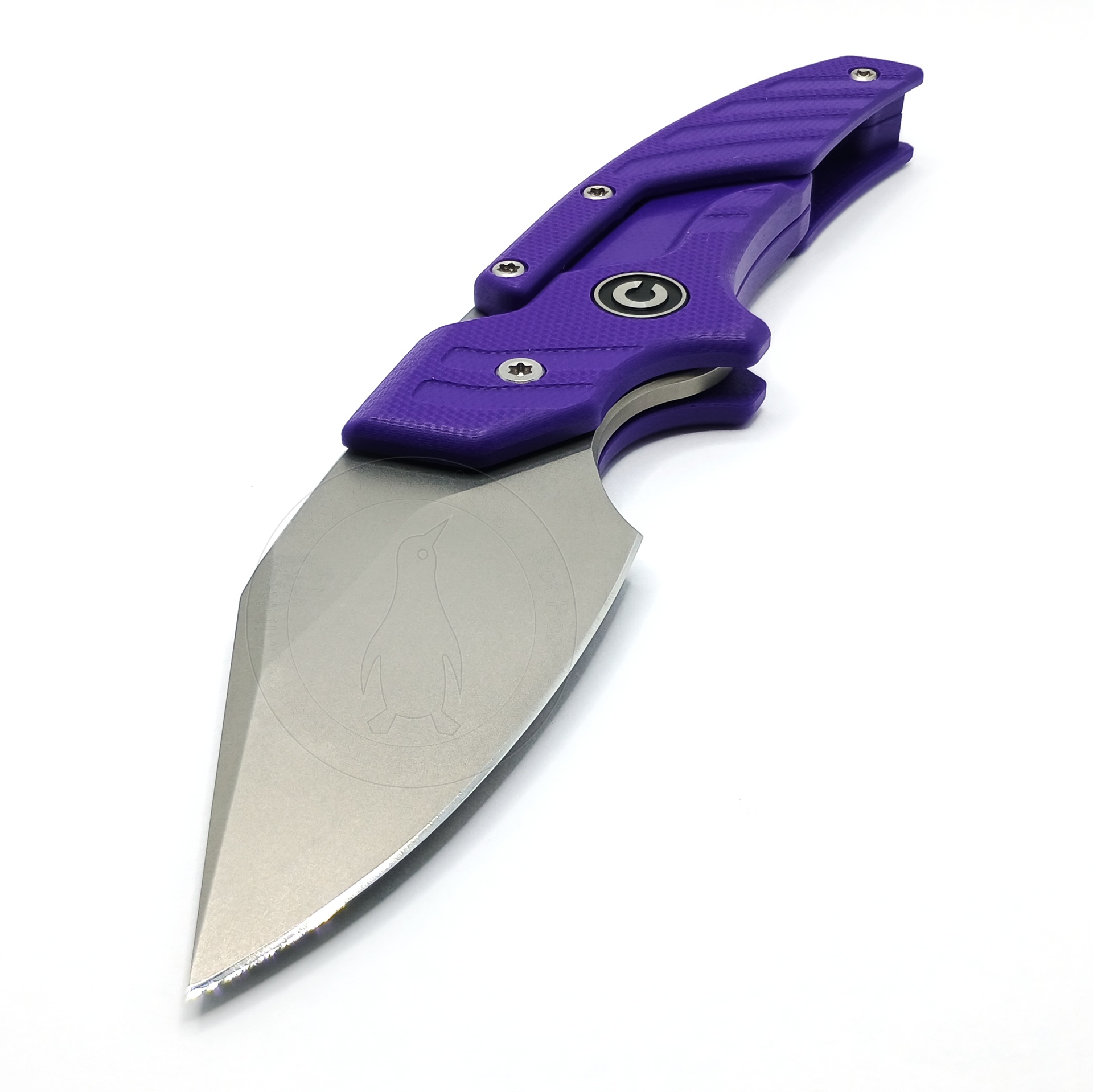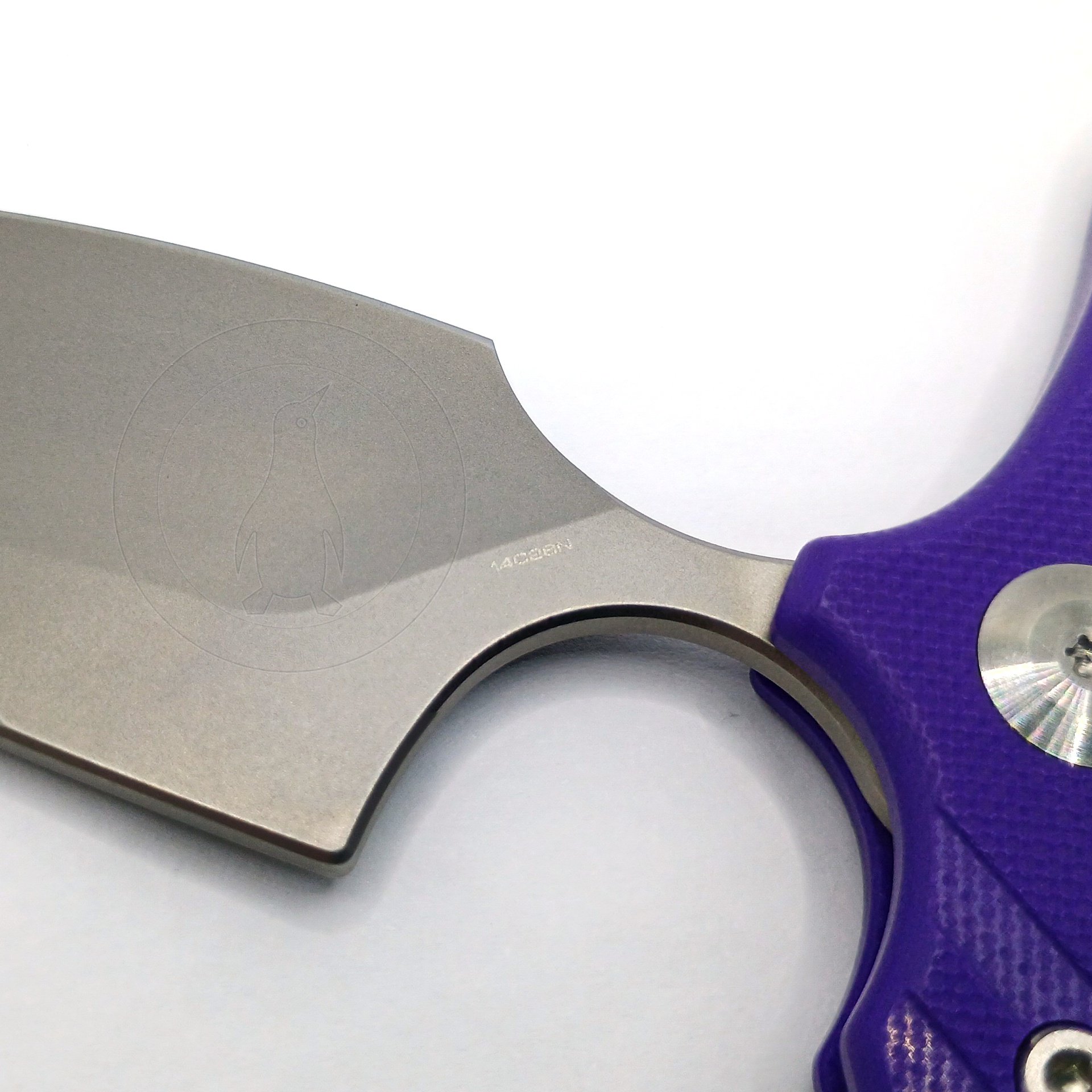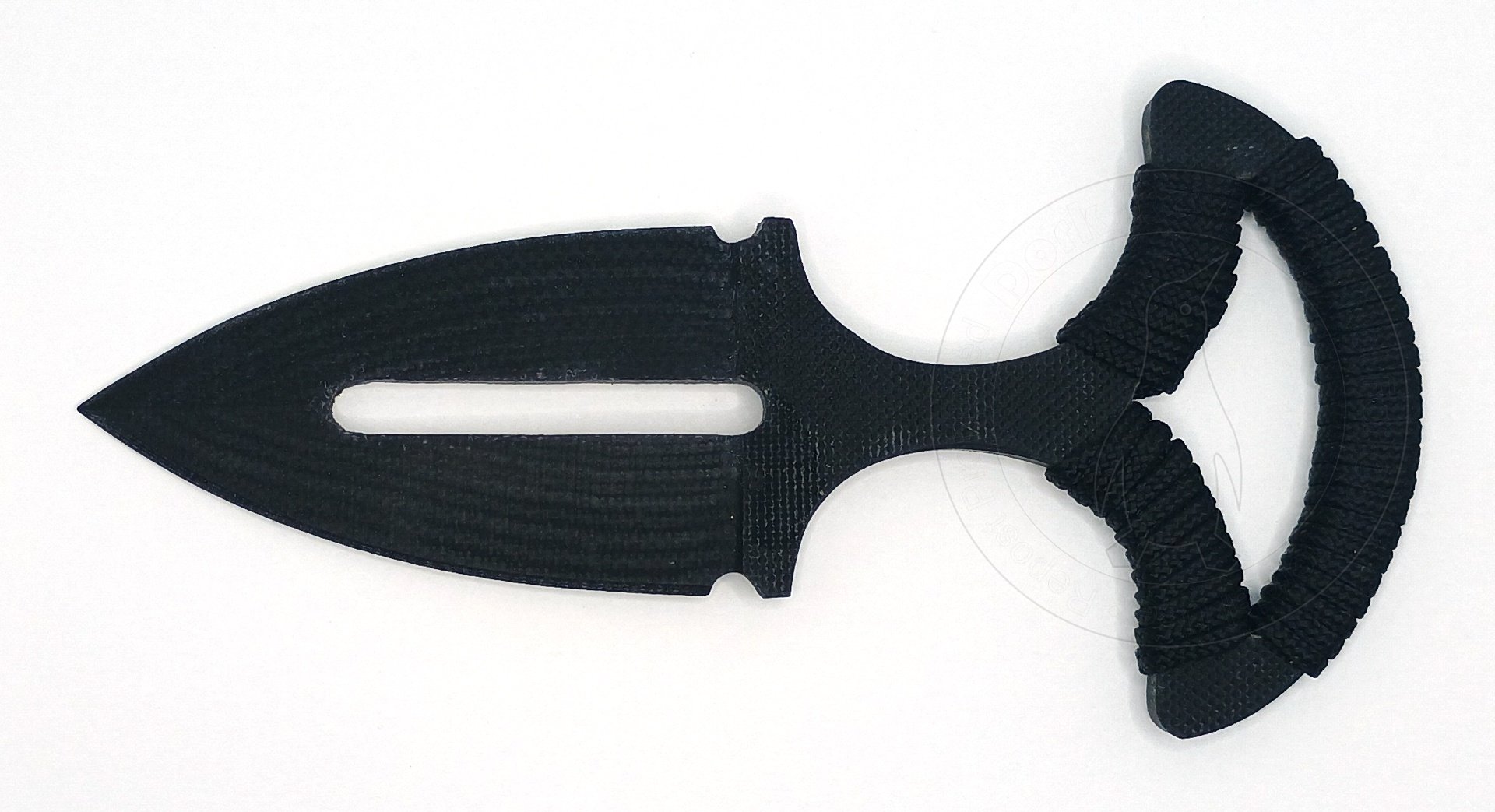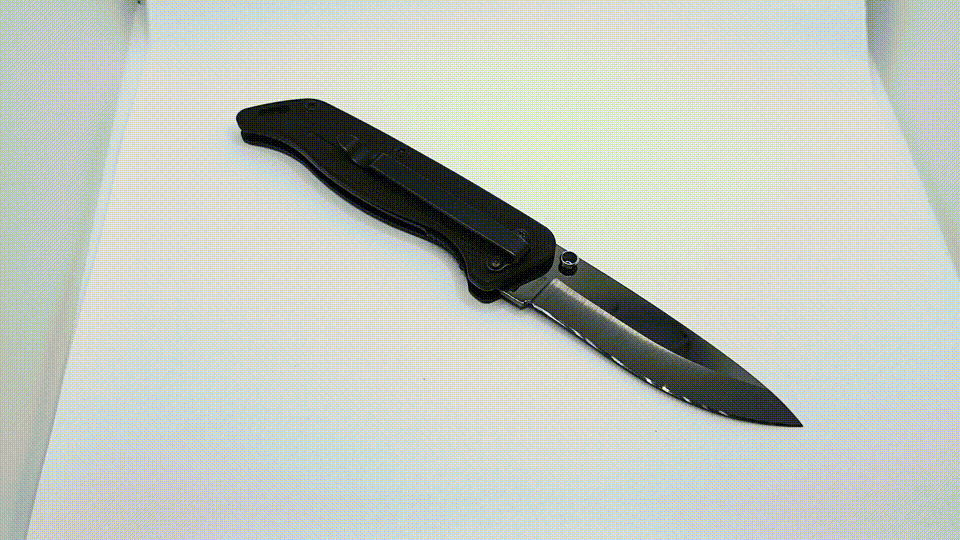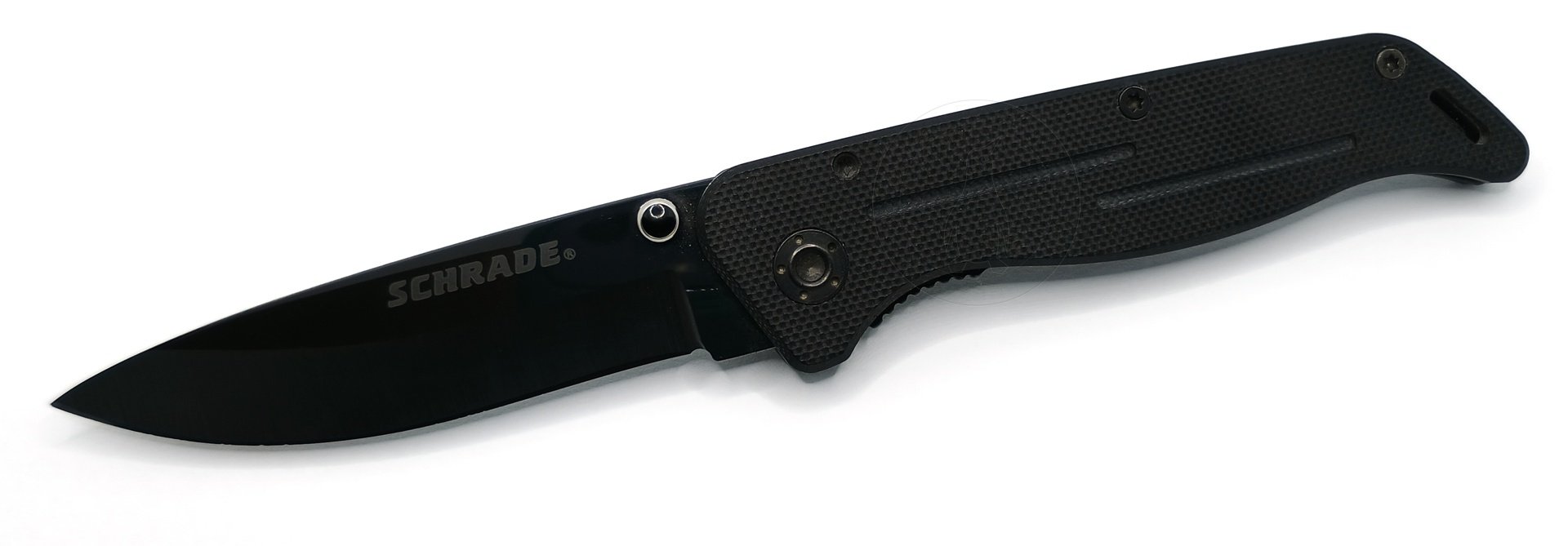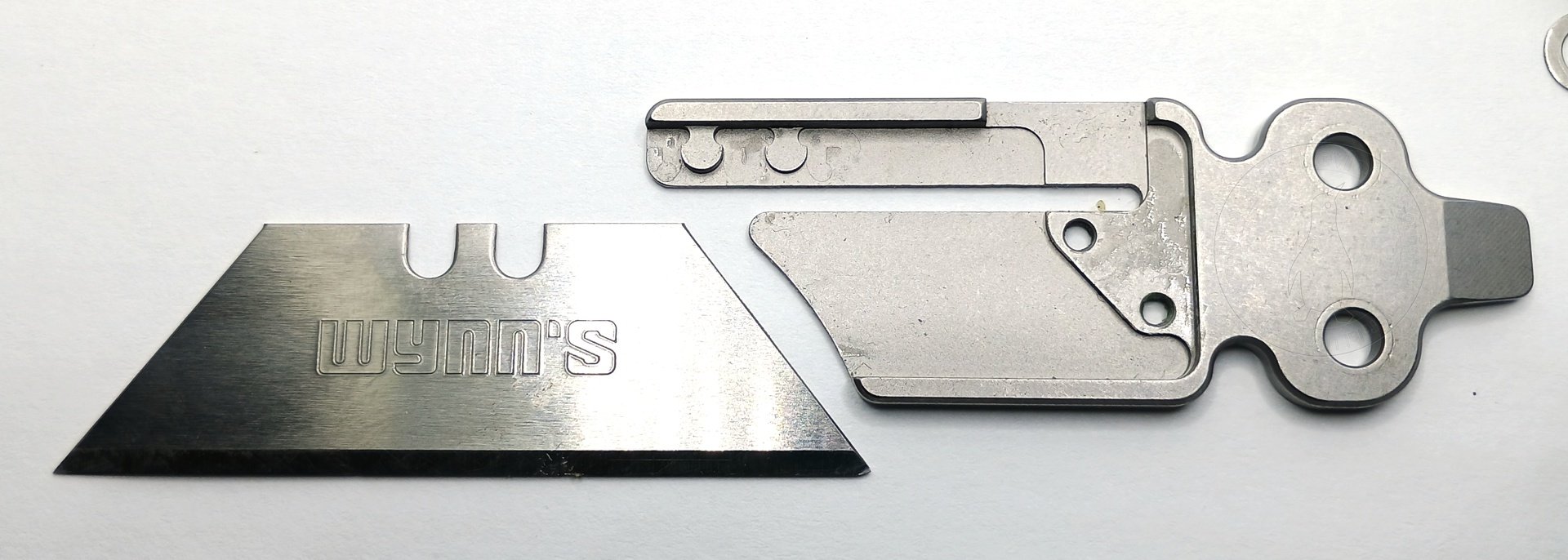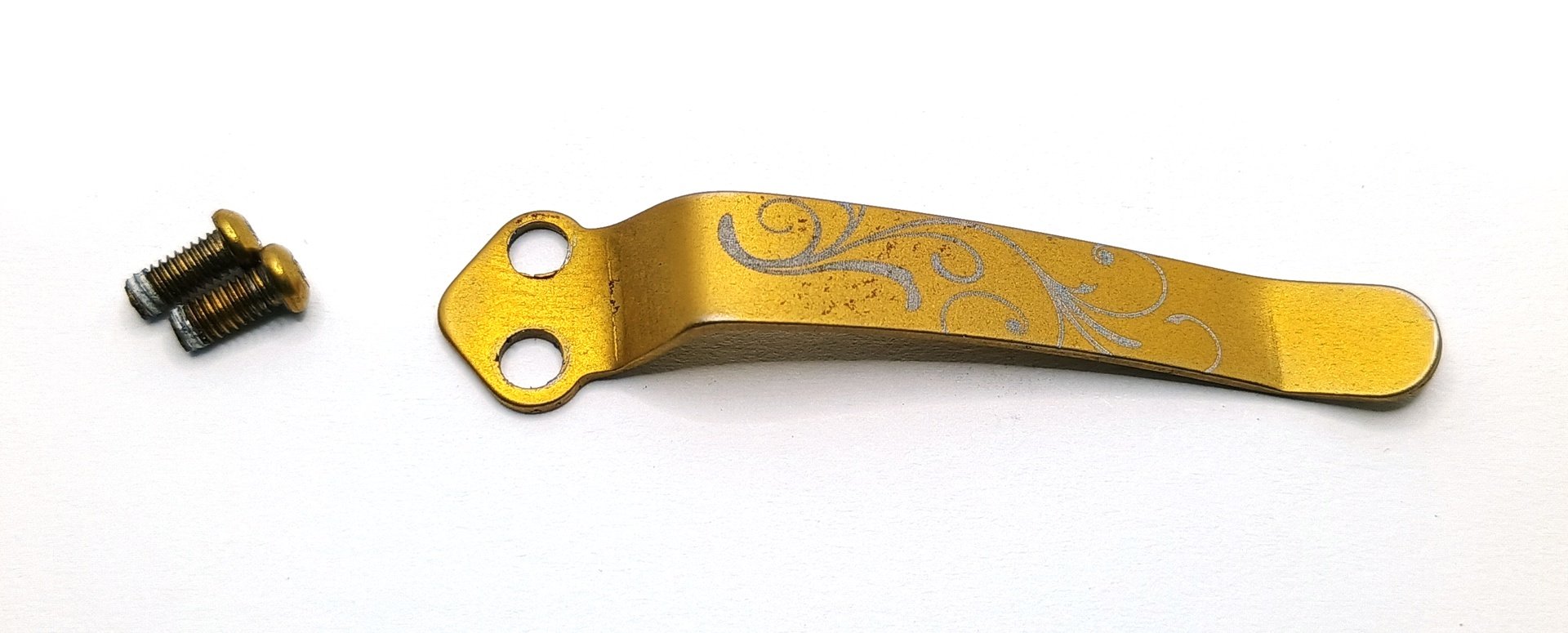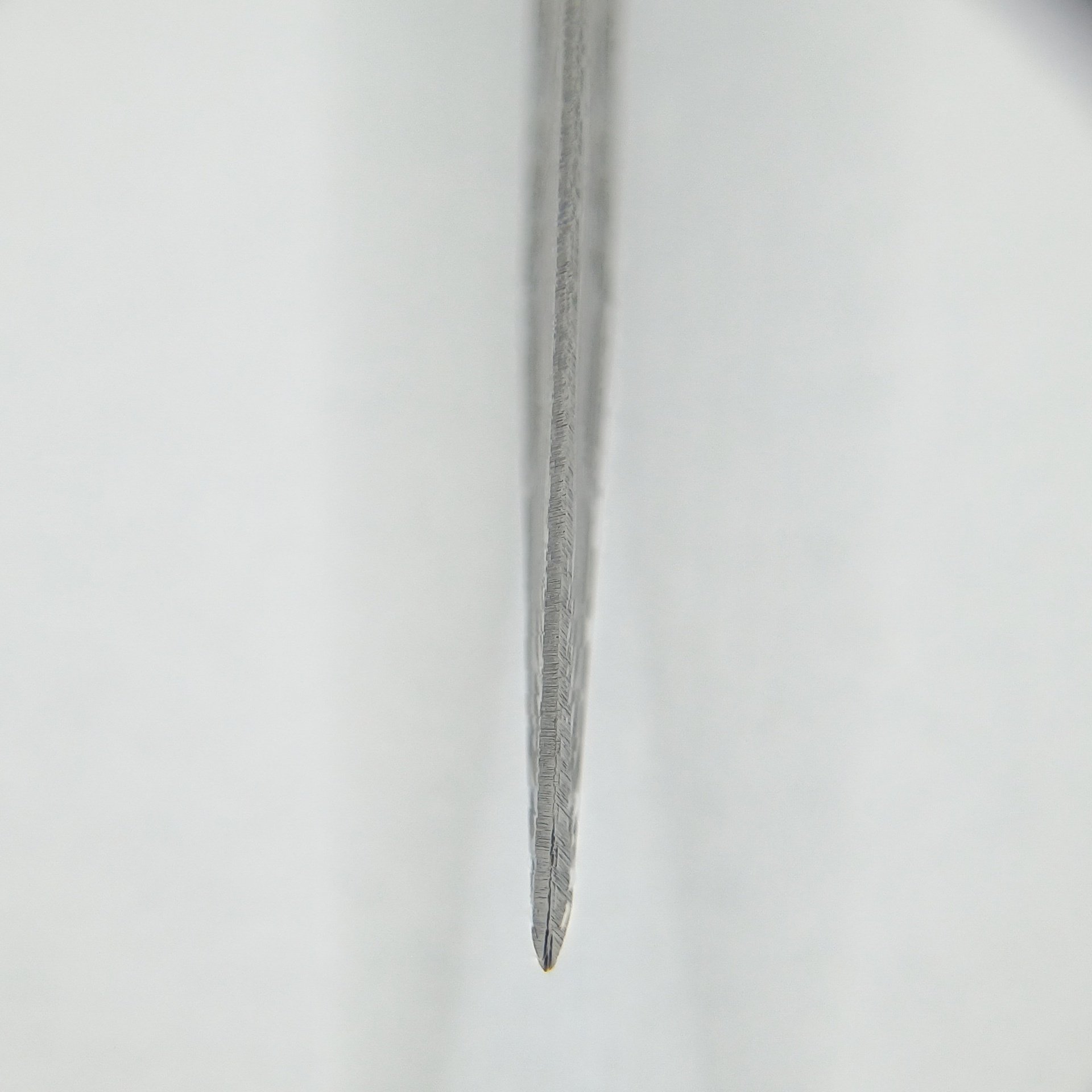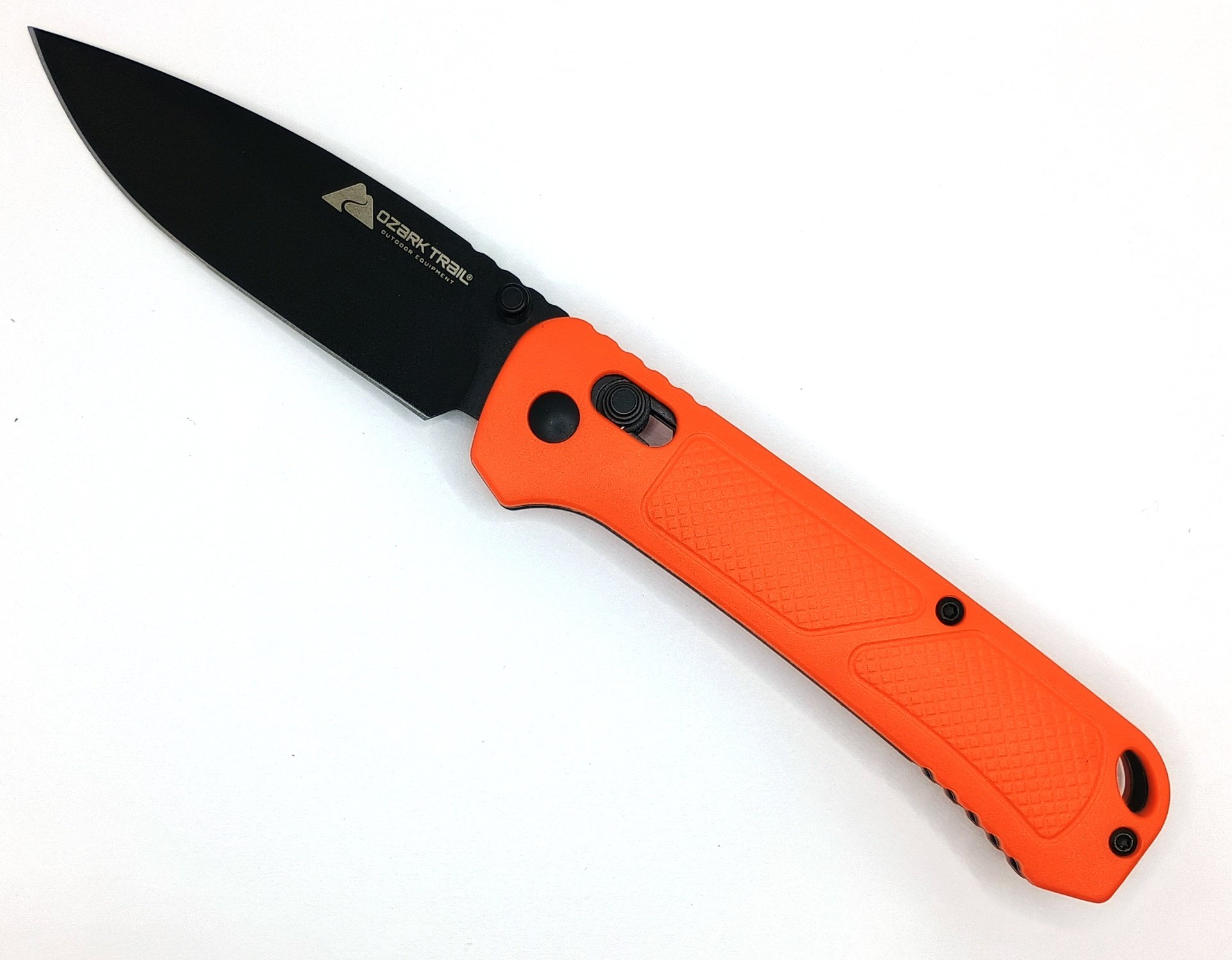I was recently alerted to a new Wal Mart / Ozark Trail release by fellow user @[email protected], yet another in their line of Benchmade-eque crossbar locking folders. A mechanism which they've finally given a name, now calling it the "slide lock."
As you know, I'm pathologically drawn to this sort of thing like an idiotic moth to a bargain basement flame. Goodness knows I've already featured enough generic Chinese garbage on here to sink an entire container ship, and that's because I think inherent to these is a certain type of bent appeal. Plus, it's a lot easier (read: cheaper) for me to buy this kind of crap on a lark just to show you guys rather than whatever the latest big-ticket collectible du jour is.
So today.
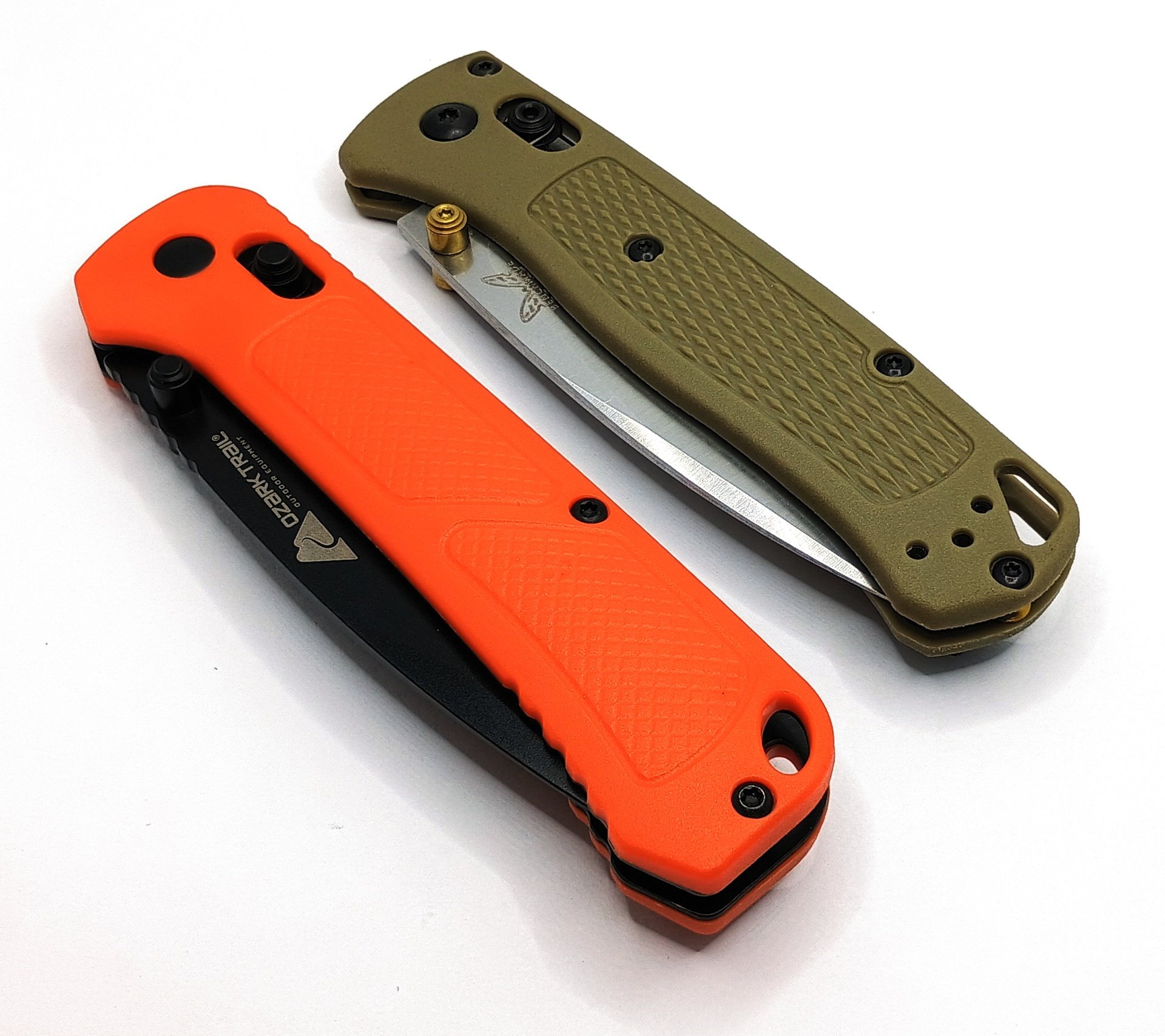
Hmm...
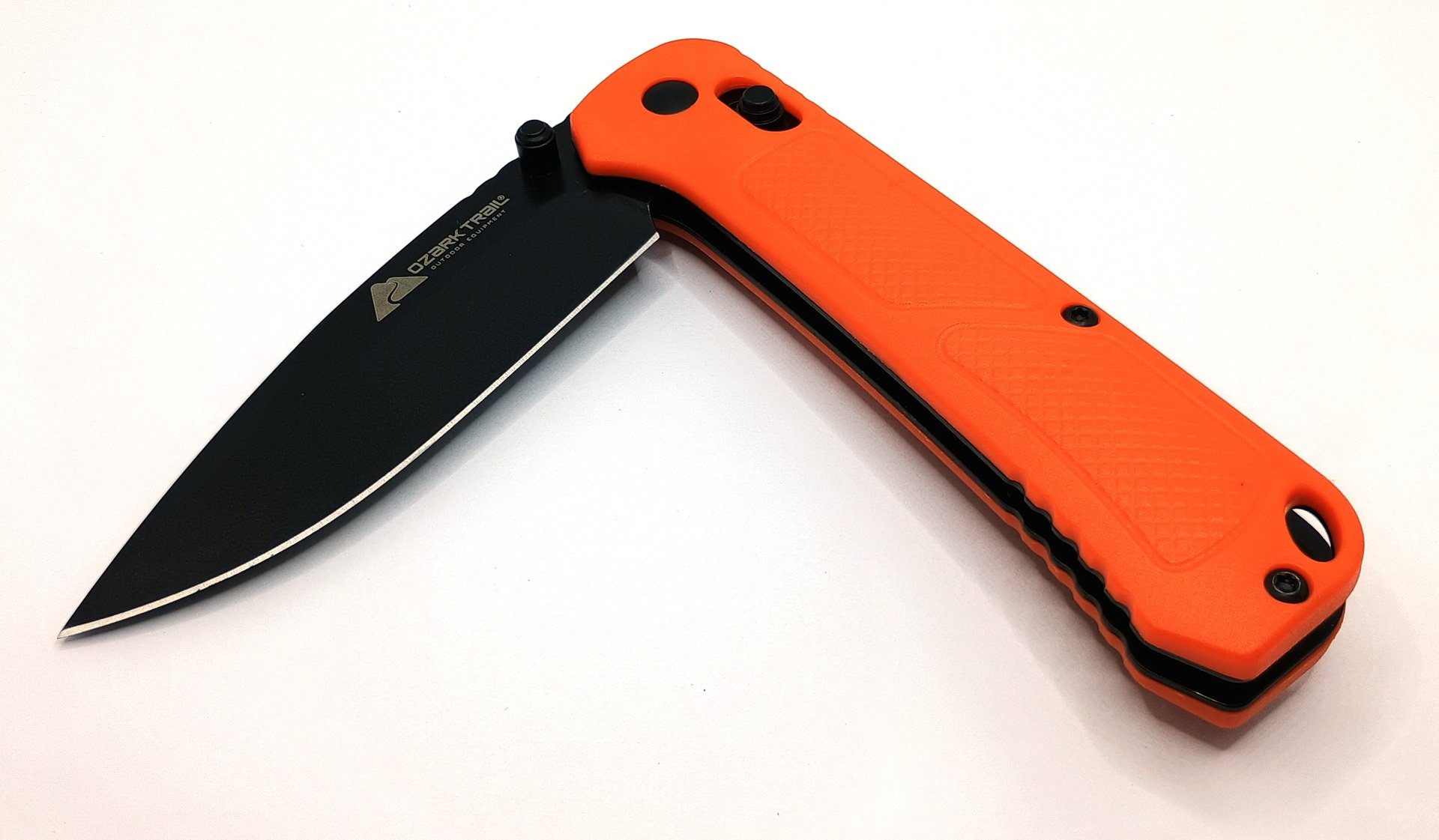
There's been a minor scuttlebutt about this knife on the internet lately. Can you guess why?
Yes, it's because whoever Walmart is using as an OEM for these knives has come just about as close as you can get to ripping off the Benchmade Bugout as you can do without getting sued so hard your underpants spontaneously combust. At least for a stateside brick-and-mortar oriented retail product.
We've seen clones of this ilk before, of course, but they've always been the purview of nameless fly-by-night nonbrands relegated to grey market drop shipped online shopping; wretched hives of implicit mediocrity like Amazon, eBay, and Aliexpress.
But this isn't exactly anonymous. You can just walk into a major store and buy one. Easily, as it happens. Unlike the last few go-rounds with this type of thing, it seems Walmart has contracted whoever-it-is to make more than, like, twelve units of these. I didn't have to do any searching to lay my hands on my example because my local store had about 30 of them in stock. And Walmart's web site indicates it's the same story at all of their other locations just about everywhere, at least for now. And at the time of writing, these retail for a princely $9.97.

And whoever-it-is still remains a mystery, although historically Walmart's private label Ozark Trail knives have been made by Hangzhou Great Star Tools Co. Ltd., a Chinese OEM for low end cutlery who are also the force behind several other budget brands. And whose web site I'm not linking this time because it appears to currently be broken. I'm not sure what that forebodes. So I can't prove they were the ones who made this, but they've made similar knives before. It's as plausible a theory as any.
So, what do you get for ten bucks and is it any better than the previous Walmart crossbar folders?


Well, the answer to the first question is this. And the answer to the second one is yes.
As usual, this appears in generic Ozark Trail packaging on a hang card that doesn't provide much in the way of information or identification. It doesn't have any kind of name aside from the uselessly nondescriptive "7.5-Inch Folding Knife," although it does appear to have a SKU of T2203R1-11 as stickered on the back of the package. These are likely subject to change without notice, because Walmart is so noncommittal about this thing's designation that the SKU and UPC aren't even printed on the actual cardboard -- they're a sticker, ready to allow the packaging they've already cranked out a billion of to be reused for the next thing.
There is also a sticker that just contains the numeral "1" in the upper right corner on the back. I don't know what that's for. Maybe where it's supposed to hang in the planogram, or which slot it corresponds to in the glass case?

Why anyone cares about this is, of course, because it's a crossbar locking folding knife like unto Benchmade's Axis lock. This sort of thing has become increasingly popular recently since -- as I'm sure you're sick of me telling you -- Benchmade's patent for their Axis lock expired in 2016 which means now anyone can have a runup at the idea. This sort of thing excites us no end, but presumably the novelty will eventually wear off.

Walmart distributes a huge array of cheap and nasty folding knives under their Ozark Trail label that are plain liner lockers or lockbacks, of course, but none of those are especially... special. Nor much good. Which is why I'm not featuring yet another one of them every ten minutes. They're just commodity disposable low quality knives, so much so that the packaging never even bothers to indicate what kind of steel they're made out of and barely even contain a bullet list with a perfunctory set of standard features.

This time, however, there's something new. For a start, we actually get a named steel! This model is alleged to be made of D2 steel, which is printed right there on the back of the card. That's already a serious upgrade over the previous two models, which were made out of... Well, nobody actually knows, really.
D2 is no longer considered exotic (such as it even ever was) and nowadays is pretty much regarded as an entry level steel. But this wasn't always the case, and even so at least we can state with some degree of confidence what the heck this knife is made out of and thus possibly predict how it should perform.
D2 is a tool steel that is tougher than the typical standard for entry level knives, 440C, and also has superior edge retention compared to 420 or 440 series steels. It's not very corrosion resistant, though, which probably goes a long way towards explaining why this knife has a black epoxy coated blade. Knife people can probably be trusted to properly maintain a semistainless blade. Any average cross-section of Walmart shoppers you care to make, well. Probably not.

The coating is consistent and even looks pretty nice with a fine texture to it that prevents it from being completely shiny, and looks pretty thick. It'll wear and get scuffed up with use, of course, but at least it appears it ought to be a while before you'll work your way completely through it.
That said, I'm not a fan of coated blades in general -- D2 or not -- and I'd much prefer if this just had a bare blade. Corrosion be damned.
The rear tells us this was made in China, as if we didn't already know. The front is printed with the Ozark Trail logo but stops short of specifying who the actual manufacturer is.

The packaging further goes on to state that this knife has an "4.25-inch injection handle." It's injection molded out of glass filled nylon if I'm any judge, since it looks, feels, and sounds exactly like the stuff e.g. if you scratch at it with your fingernail.
Insofar as I can tell this knife comes in only one color, which is Ostentatious Orange. This will probably appeal to the Mossy Oak crowd whose custom it will undoubtedly attract; for the rest of us it means at least you'll be able to find it again if you drop it in the weeds.
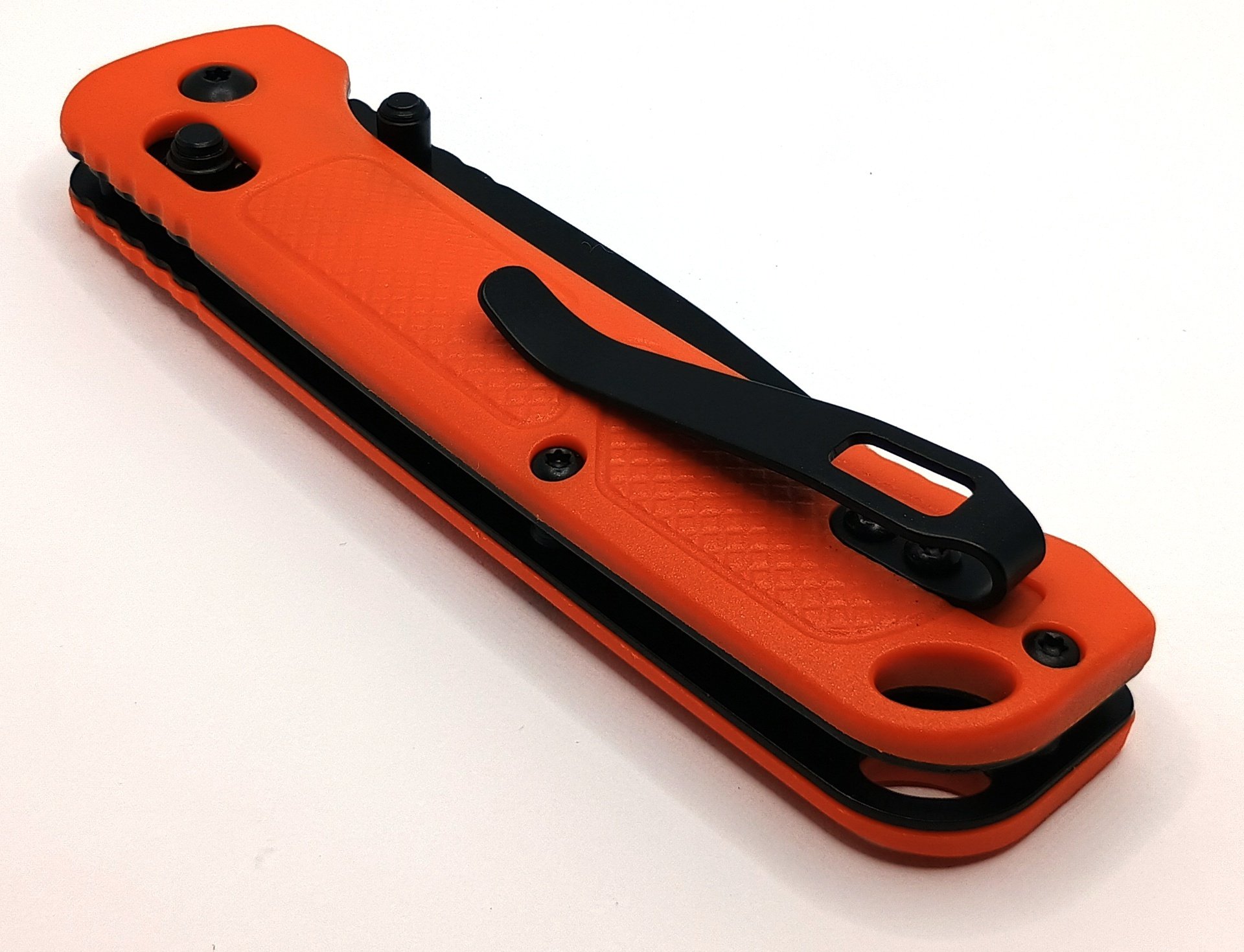
The T2203R1-11 is fully ambidextrous as far as the controls go, but its deep carry pocket clip is not reversible. It carries tip up only with the clip on the left side when held with the blade deployed and the edge out. And that's your only option, short of taking it off.

Look, we may as well rip this Band-Aid off all in one go. There's no denying that this is manifestly meant to be a poor man's Bugout. The comparison to Benchmade's perennially dominant bantamweight folder just can't be avoided. The T2203R1-11's design clearly started by copying Benchmade's homework, and the details were shuffled around just enough to keep the men with briefcases and very somber ties from showing up at the door.
So the overall vibe of the deep carry clip, the molded fiber-nylon handles with checkered grip pattern, Axis/crossbar lock, the blade shape, and the lanyard hole worked into the scales on the top rear corner of the knife, it's all deeply reminiscent. Oh sure, the shape of every design element is just different enough to remain Legally Distinct. But you can see how it is.
Even the sizing is the same. Looking down on it flat from above, the Ozark's footprint is functionally identical to the Bugout. 7-1/2" long overall when open, 4-1/8" long closed, with a 3-1/4" drop pointed blade. The blade is 0.89" thick, which is basically the same as the Bugout's as well.

But you see, where it differs significantly is in construction methodology and thus the thickness. And it sort of solves what, er, bugs everyone about the Bugout. Benchmade are so confident in the strength of their fiber reinforced nylon handles that the Bugout eschews handle liners entirely. But I'll bet you whoever made this wasn't. So the Ozark has full length steel liners beneath its scales. As a consequence, then, it's thicker: 0.533" across its scales, not including the clip. So it's 0.144" more than the Bugout, which is enough to be noticeable. But it's also significantly more rigid than a Bugout and if you ask me more confidence inspiring in the hand.
Naturally this must mean that the Ozark is heavier than a Bugout, too. And it is, at 80.5 grams or 2.84 ounces. (That's 29.4 grams more, if this matters to you for the purposes of backpacking and/or being launched into space.)
The Ozark's blade is also hollow ground whereas the Bugout has a flat grind. That's to be expected, really, because doing a true flat grind is expensive and a hollow grind isn't. (In fact, if you're using a grinding wheel to create your blade's bevel it's very difficult not to naturally wind up with a hollow grind.) But all that notwithstanding, it's still got nice machined aluminum diabolo spacers separating the halves and everything.

The Ozark T2203R1-11's scales are a little more rounded and the texture molded into them is not as aggressive as the Bugout's. That makes it theoretically less grippy on paper, but in reality it's unlikely to matter. The Ozark has some jimping on the back of its handle right above the lock but it also has some at the base of the spine of the blade whereas the Bugout doesn't.
Oh, and the Ozark's draw from the pocket off of its clip is much nicer than the Bugout's. I imagine this is down to the smoother texture on the scales, but no matter how you come at it, it's noticeably easier to draw despite the clip still providing more than sufficient retention to keep it from just falling out of your shorts if it's inverted.

It also costs $170 less than a Bugout. Make of that what you will.

The previous Ozark crossbar lockers were cheap and cheerful, but really left a lot to be desired in the action department.
This doesn't.

I'm going to skip ahead a bit here, because the other update this knife got is a big one. It's got ball bearing pivots. And you know I am all about that.
Yeah, that's right. No more shitty plastic washers and no more dicking with your pivot screw tension to find the magical quarter of a degree where the blade neither locks solid nor wiggles like an extra on a Jason Derulo set.
The T2203R1-11's action kicks ass. It's not spring assisted, but it doesn't have to be. Give the thumb studs a little push and it flies open like you've got telekinesis. Hold the crossbar back and it'll Axis flick open and closed extremely readily. And its travel is basically completely silent until the lock clicks into place.
This puts the Benchmade original in the rather unfortunate and unenviable position of being outdone in both hand feel, draw, and action by an off brand $10 piece of shit that hangs on a peg right below the telescopic hot dog fork and just above the plastic whistle and compass carabiner. That's got to hurt.
Actually, all of this does raise one point of contention. I think this would have been even better if it were a Mini Bugout knockoff instead. See, at a 3-1/4" blade length this knife is slightly above the typical magical legal maximum of 3" which'll get it automatically Naughty Listed for carry in a lot of places. The Mini version's blade is 2-7/8" which cruises under that limit. It would be especially cheeky, not to mention beneficial for a lot of people, if this did the same. Oh well.

While we have it apart, here's what the liners look like. They are plain steel, not aluminum or anything else fancy, but they do have holes machined into them to at least make them somewhat lighter.

The full bill of materials.
All this is minus two screws compared to the OG Bugout, because the latter requires one screw in each scale to retain the little crossbar liner plates and this obviously doesn't need to resort to any such trickery.
For $10, it's not hard to guess that a Benchmade will certainly be put together much more nicely than this, and so it is. My example had inconsistent screw tension all around, and there are no anti-rotation features on the spacers which also had their screws threadlocked into place. Getting the spacer screws out on both sides is absolutely mandatory for disassembly of crossbar/Axis locking knives like these, because this allows for removal of the scales which is necessary for getting the lock crossbar out before you can fully separate both halves. I wound up having to grab one of the spacers on mine with some padded pliers -- with quite some force, as it happens -- to get both screws out.

I'll be damned if this thing doesn't have an honest to goodness fully functional anti-rotation flat on its pivot screw, though, complete with a matching D shaped hole in one of the liners. That also makes guessing which of the two liners the female end of the screw goes into completely idiot-proof.

As you can see here, the clip is under an alarming amount of tension at all times, based on how much of a bend there is in it. It still draws cleanly as described, though, so I guess I can't argue with results. Once again like the last two Walmart crossbar lockers the screws go inside the clip and are accessed via a hole in it, and are not placed to either side like on a Bugout. And once again they are not flush with the inner surface of the clip, but there's enough of a throat in it that I didn't find this to actually be a problem. Its width at its throat, where the U bend is at the end of it, is actually noticeably wider than on a Bugout. It's slightly wider than the last two Walmart crossbar knives, too.
My only other note on the clip is that despite ostensibly being "deep carry," it's mounted with its top end about 1/4" down from the tail end of the knife, which means that a noticeable portion of bright orange knife is left peeking out above the hem of your pocket like Kilroy at all times. Don't you think that kind of defeats the purpose?

Here's all the hardware. The only booby trap inside is the endstop pin, which is not shouldered nor retained in any way and can fall out as soon as you remove either of the scales. The rest is completely straightforward, and all the screws are even all the same as each other (although I separated out the two for the clip in this photo, that turned out to be unnecessary). That means there is no way to wind up with an Idiot Mark on your blade by fucking up and installing a too-long screw in the wrong position so it pokes out past the inside of your liners. So that's nice for retaining the finish on your $10 knife.
When all is said and done, a genuine Bugout is definitely more user-friendly to disassemble to fiddle with or to clean, and it provides you more options. The Bugout has a reversible clip and this doesn't. You can dismount the thumb stud easily on a Bugout by unscrewing it as well, whereas this one appears to either be press fit or very firmly glued into place with no evident screw heads into which to insert a tool.

Obviously you can't expect the edge on this knife to compare favorably to one that costs 18 times more, so the Ozark T2203R1-11 doesn't. A genuine Benchmade has a much finer edge and its grind is clearly superior, but I have to say the Ozark still isn't bad. The grind is acceptably fine for a working knife...
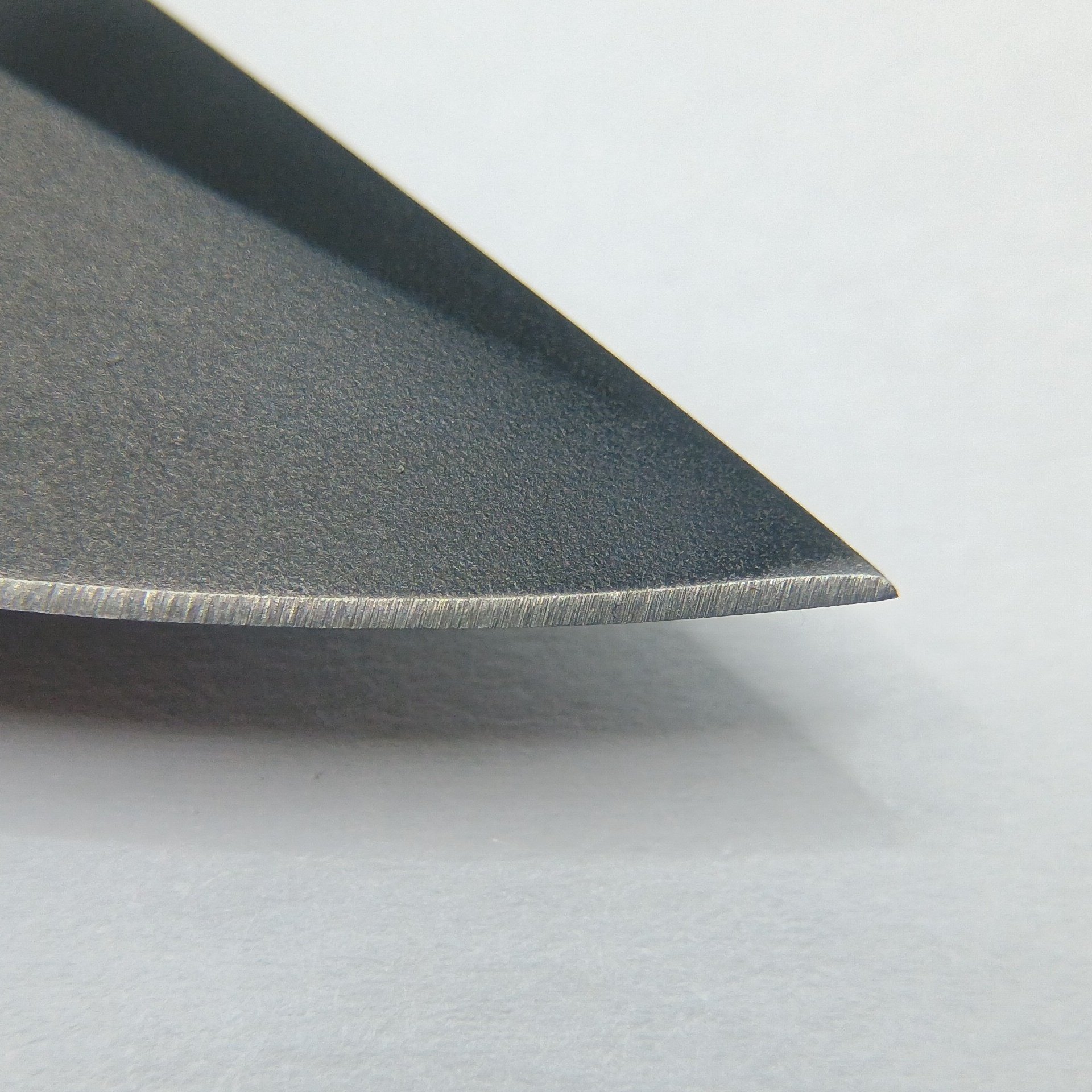
...And carries on pretty consistently all the way to the tip.

The edge is just slightly out of true, but should be well within reach of correcting by anyone with either a storebought guided sharpener or a stone and a modicum of skill. I'm not going to go so far as to say I'm impressed, but I'm definitely not disappointed.
The Inevitable Conclusion
It's been interesting to watch evolution in action with these Walmart knockoff knives. We've seen them develop from trash to broadly functional if a bit weird, with the previous run of crossbar lockers, to this model which is -- if I dare even say it -- actually pretty good.
You have to be careful where you tread with statements like that. I'll make a lot of people with expensive knives very angry indeed if I take it too far.
So all this isn't to say that the T2203R1-11 is as good as a Benchmade Bugout, because it isn't. A Benchmade is better built, more nicely machined, comes from the factory with a better edge, is easier to take apart, and is made of much fancier steel.
But the Ozark's action and clip are genuinely better than the Benchmade. And that's a hell of a thing, isn't it? The Benchmade is better quality, yes. But not, it must be said, 18 times better. Four, six, or maybe eight times better, sure. You'll get no argument from me there. But the price disparity between these two for the actual difference is quality is absurd.
For $10 I think this is a fantastic deal. And barring any unexpected surprises like finding out later that the entire batch had a uselessly bad heat treating job or something, that comes without all the usual qualifiers. It's not, oh, a good kinda-sorta okayish backup knife to leave in the glovebox, just in case, you know, better than nothing.
No. This is genuinely a decent knife. For $10. If I actually had to carry this knife exclusively for a month, for instance, I certainly wouldn't be mad about it.

I just wish I didn't know what I already know about this knife and others of its kind. Things like how it doesn't even have a name. I mean, two decades from now, nobody's going to remember this thing. Nobody's going to say, "Yeah, the T2203R1-11, back in 2024? That was where it was at."
Fucking "T2203R1-11?" Come on.
It'll be a flash in the pan, here today and gone tomorrow, and nobody upstairs will care. To Walmart it's just another faceless commodity product, one of a million, and if they're actually turning a profit on this at $9.97 then I shudder to think of what it actually costs to produce... and by who. The sad truth of it is, it's probably only any good by accident. They probably think they're ripping us off with this, same as they do with everything else. I'll bet you neither Walmart nor their OEM set out to build a knife at this price point and as decent as this on purpose. And sooner or later some bean counter somewhere will figure that out, he'll get ordered to widen the margins on it, and it'll be ruined and that's the end of that.
You can never win a race to the bottom.
But every now and again you can get lucky, jump on, and enjoy a damn good ride for just a little while.


